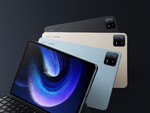Xiaomi Pad 6 Pro
Spécifications de l'ordinateur portable

Appareil photo secondaire: 20 MPix f/2.2, 0.8µm
Price comparison
Moyenne de 1 notes (à partir de 6 critiques)
Critiques pour le/la Xiaomi Pad 6 Pro
Source: Tech Amaze
 EN→FR
EN→FRIn the software section, the balance does not lean much towards Xiaomi. The lack of features that we are used to seeing in Samsung’s Dex and iPad OS, deals a big blow to the user experience of the Pad 6 Pro, to the point that the differences between MIUI Pad and MIUI are almost negligible and we can’t consider it a separate personality from the user interface of Xiaomi smartphones. In terms of hardware performance, we see everything we expect from the Snappdragon 8+ Gen 1 chip in the Pad 6 Pro. Excellent performance stability, great performance in games and CPU tests can reassure us about the processing power of the Xiaomi tablet. Finally, we get to the discussion of the price of the Xiaomi tablet and its value for money. As we mentioned in the introduction and throughout the review, the price difference between the Pad 6 Pro and its rivals is quite noticeable. Keep in mind that Samsung gives you its tablets with a pen, but you have to pay a separate fee for Xiaomi’s Smart Pen (and of course the Xiaomi tablet keyboard) and Apple Pencil.
Critique simple, disponibles en ligne, Très longue, Date: 02/01/2024
Source: TechTablets

Critique simple, disponibles en ligne, Très longue, Date: 05/01/2023
Source: Igeekphone
 EN→FR
EN→FRHowever, the comments mentioned at the press conference do not occupy the screen and will pop up from the right. This point is not yet implemented in the current version and should be added in the subsequent official version. Fortunately, the mainstream long video platforms have already done an excellent job of horizontal screen adaptation, and there is no frame lock, and there is no obvious problem in the experience. Under the premise of the current Android tablet market environment, Mi Pad 6 Pro is a product that is stacked and balanced on the hardware as much as possible and gradually completes the functions and perfect experience on the software, which is commonly known as the bucket machine. As far as the results are concerned, the appearance design of the Xiaomi Pad 6 Pro is not very brilliant, but at least it can’t go wrong. The screen and performance experience is remarkable, andcan’ttexture of the accessories is further enhanced, making up for the shortcomings. It should be said. It is a more genuine product, and it is also a product suitable for a good life.
Critique simple, disponibles en ligne, De taille moyenne, Date: 04/20/2023
Source: Root Nation PL
 PL→FR
PL→FRCritique simple, disponibles en ligne, Longue, Date: 08/02/2023
Notes: Note globale: 70% écran: 70% mobilité: 80% finition: 90%
Source: Unite4buy
 PL→FR
PL→FRCritique simple, disponibles en ligne, De taille moyenne, Date: 04/20/2023
Source: Viettelstore
 VN→FR
VN→FRTravaux pratiques, disponibles en ligne, Courte, Date: 05/23/2023
Commentaire
Qualcomm Adreno 730:
Puce graphique pour smartphones et tablettes intégrée au SoC Qualcomm Snapdragon 8 Gen 1. Qualcomm affirme qu'elle est 30 % plus rapide que l'Adreno 660 du SoC Snapdragon 888. Pour Android, elle devrait être l'une des cartes graphiques les plus rapides fin 2021.
Ces cartes devraient être capables de faire tourner tout les jeux d'aujourd'hui, mais la plupart d'entre eux uniquement en détails moyens ou faibles et avec des résolution basses. Les plus vieux jeux ou les jeux moins gourmands restent jouables avec de beaux graphismes.
>> Plus d'informations sont à trouver dans notre comparaison des cartes graphiques mobiles et ainsi que dans notre liste des Benchmarks affiliés.
SD 8+ Gen 1:
SoC haut de gamme pour smartphones, introduit fin 2021 et fabriqué en 4 nm chez TSMC. Il intègre un "Prime Core" basé sur une architecture ARM Cortex-X2 cadencée jusqu'à 3,2 GHz. Trois autres cœurs de performance sont basés sur l'A710 mais cadencés jusqu'à 2,5 GHz. En outre, quatre cœurs d'économie d'énergie sont intégrés, basés sur l'architecture ARM Cortex-A510 et cadencés jusqu'à 1,8 GHz. En plus des cœurs de processeur, le SoC intègre un modem WiFi 6e, un DSP Hexagon (pour l'accélération de l'IA) et un ISP Spectra. Le contrôleur de mémoire intégré prend en charge la mémoire rapide LPDDR5 jusqu'à 3 200 MHz. La 5G est désormais incluse dans la puce avec le modem Snapdragon X65. Par rapport à la version non plus, le 8+ Gen 1 offre un Prime Core cadencé à 200 MHz de plus et un GPU cadencé à 10% de plus. De plus, elle est désormais produite par TSMC et non plus par Samsung.
>> Plus d'informations sont à trouver dans notre comparaison des processeurs mobiles.



